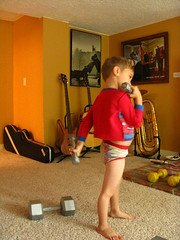Here’s a (sort of) taboo topic- children lifting weights. In other sports, kids are started out super young and train their whole lives if they are to make it to the professional level by the time they reach the age to do so. Let’s use the Olympics for example, those athletes you see there have  probably been training every day since they were in elementary school- some even younger! Most people don’t bat an eye at young soccer players, ice skaters, gymnastics, or even golfers- so why is the idea of a little kid strength training so odd to many people?
probably been training every day since they were in elementary school- some even younger! Most people don’t bat an eye at young soccer players, ice skaters, gymnastics, or even golfers- so why is the idea of a little kid strength training so odd to many people?
A few years ago, a video emerged showing Tiger Woods driving a golf ball like the pro that he is. The only catch: He was just 2 years old at the time. (Two years old!)
The message to parents: If you want your kids to excel in sports, you need to start them young. Of course, beyond developing specific skills—such as throwing, kicking, and swinging—improving strength, power, and speed are key components of sports performance training.
—-
Like we were saying, other sports are filled with once child athletes that dominate their field. Case and point, Tiger Woods, think what you want about his personal life but there’s no denying that he rules golf. We don’t think Woods would be so in touch with his club and ball if he hadn’t started off when most children are just learning to run without falling.
Watch this video of suggested moves for adolescent weight training…
—-
Some experts warn that weight training at a young age can damage a child’s growth plates. And that concern has merit. “The dangers to growth plates—found at the end of long bones—are real,” says Michael Meija, C.S.C.S., Men’s Health fitness adviser and owner of B.A.S.E. Sports Conditioning, an organization that specializes in youth athletic training.
However, Mejia is quick to point out that these injuries are almost always the result of using too much weight with improper technique. Plus, he adds that smart strength training is absolutely acceptable—as long as the right exercises are chosen and that the youth has an appropriate level of base strength and mobility. (Looking for a plan for you? Discover the cutting-edge fitness system that will melt fat, torch calories, and sculpt every single muscle in your body!)
“Exposure to a variety of sports and fitness-based games—such as tag and tug of war—is the best approach for younger kids,” says Mejia. “But as they reach that middle and high school age, you can start implementing more of a structured approach to strength training.”
But proceed with caution: “Even when kids are ready for weights, the loading is often times imbalanced and that leads to problems down the road.” One common problem: “People put too much focus on popular exercises like the bench press, and start piling on weight even before a kid can do 10 good pushups,” says Mejia. “That’s a recipe for injury.” Mejia’s advice: Before a kid ever touches a weight, make sure she can perform basic body-weight exercises with perfect form.
—-
So, weight training when a kid is too young can be dangerous. If their bones aren’t developed enough, it could damage their growth plates- according to some experts. On the other hand, these injuries are related to overdoing it and improper training. The same experts that caution against it do admit that proper training is totally okay.
What we think is that maybe parents aren’t the best weight training coaches unless they have experience and training otherwise. This is true for all sports though, if you want to keep your children safe during training, use a professional and check their credentials!
Another word of caution is to keep the exercises diverse. Too many reps of one thing can stress the young frame.
—-
5 Strength Rules for Kids
1. Master the basics first. Work on the two movements above—the pushup and overhead squat—until they can be completed correctly, says Mejia. If your kid doesn’t pass the body-weight tests with a score of 3, he or she is not ready for actual weights. That’s perfectly fine, by the way. These movements require total-body strength that will help in just about every sport. So by improving at them, you’ll develop a more sound athletic foundation. (Want a great new move to chisel your abs? Discover The Pushup That Blasts Your Core.)
2. Once your kid aces the tests, focus on compound, multi-joint movements. Choose exercises that emphasize the upper back, core, and hips, says Mejia. Think: Less benching, more rowing. Smart exercises to include: stability-ball leg curls, inverted rows, and reverse flys with light dumbbells.
3. Stay away from most machines. Many gym machines—such as the leg extension, leg press, and chest fly (a.k.a pec deck)—force kids to work through unnatural movement patterns that have little carryover to sports and activities of daily living. (Cable machines are the exception.)
4. Watch the weights. Poor form and excessive loading are the reasons kids wind up injured. Once they’ve mastered their own body weight, start with a resistance that allows for 12 to 15 repetitions with perfect technique, advises Mejia. “Just one or two sets per exercise is fine initially, working up to a maximum of three once strength and endurance improve.” And be sure not to take any sets to the point of muscular failure.
5. Use a variety of strengthening equipment. Medicine balls, bands, and cable-based machines allow for three-dimensional movement. These are ideal because they offer kids variety, while training balance and stability just like free weights, says Mejia.
—-
Here’s our breakdown on the rules so they’re easier to remember:
• Make sure the child knows the basic moves first before moving on to more challenging arenas
• After mastering the basics, move on the compound and multi-flex moves
• Avoid the machines; those are not designed for children, stick with free weights
• Slowly build up the amount of weight lifted
• Use a variety of equipment such as medicine balls, cables, etc.
Do you know any youth weight lifters?
|
Gain 10lbs of Muscle in 30 Days?
Grab this free Muscle Gaining Plan that includes the workout and diet plan. Just Enter Your Email Below.
|

|

|
We hate spam just as much as you
|


{ 0 comments… add one }